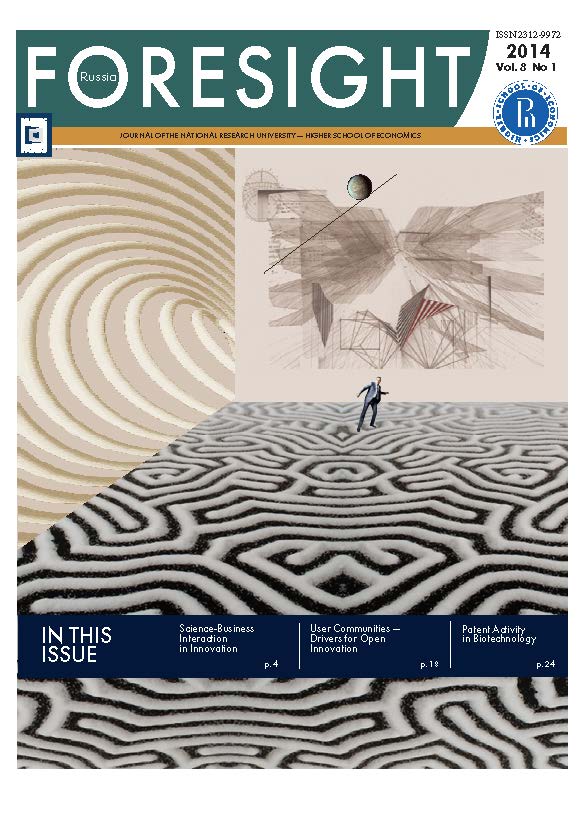Abstract
Co-operation, knowledge co-creation and exchange are core components of modern economic models of innovation development. Intensity and efficiency of linkages is widely considered as one of the major determinants of innovation system performance.
This paper presents empirical estimates of the scale and character of interactions between companies and research organisations in the Russian economy. The data are derived from the surveys of 1000 enterprises (2011) and 1000 research organisations (2012). The questionnaire is designed to allow characterization of cooperative practices and knowledge demand and supply.
One of the key findings on the demand side is significant heterogeneity of involvement by sectors in the knowledge transfer process. Specific sectors (e.g. petrochemistry, equipment manufacturing) are tightly integrated with R&D institutions, while others (e.g. consumer goods, wood processing industries) are not linked to the Russian S&T development complex. This diversity of practices is partly determined by the overall allocation of resources within the economy as well as specific competition regimes that limit short- and medium-term benefits from R&D.
Similarly, on the knowledge supply side, R&D organisations do not treat technology transfer as a priority strategy for sustainable development. Indeed, they focus on intellectual services instead of R&D, that is, on consulting andmodification of existing technologies. Among innovation-active companies, only 14% rely on the R&D results of Russian research centers. Of those actually engaged in co-operation, 12% of companies indicate implementation of new-to-the-world products or production processes and 29% new-to-the-country innovations.
Generally, low demand for R&D meets limited novelty of research results produced by the research organisations (compared to the technologies available on the global markets). Thus there are limited enclaves of efficient co-operation. These are mainly grouped around traditionally arranged institutional linkages as well as existing allocations of financial resources across the economic sectors.
References
Arundel A., Hollanders H. (2005) Innovation strengths and weaknesses. European Trend Chart on Innovation. Brussels: European Commission.
Brödner P., Kinkel S., Lay G. (2009) Productivity Effects of Outsourcing. New Evidence on the Strategic Importance of Vertical Integration Decisions//International Journal of Operations & Production Management. Vol. 29. № 2. P. 127-150.
Cohen W.M., Nelson R.R., Walsh J.P. (2002) Links and Impacts: The Influence of Public Research on Industrial R&D. Boston, MA: Harvard Business School Publishing.
Drucker P. (1985) Innovation and Entrepreneurship. New York: Harper & Row.
Etzkowitz H., Leydesdorff L. (2000) The Dynamics of Innovation: From National Systems and «Mode 2» to a Triple Helix of University-Industry-Government Relations//Research Policy. Vol. 29. P. 109-123.
Farina C., Preissl B. (2000) Research and Technology Organisations in National Systems of Innovations. DIW Discussion Paper № 221. Berlin: DIW.
Freeman C., Soete L. (1997) The Economics of Industrial Innovation. London, Washington: Continuum.
Godin B. (2006) The Linear Model of Innovation: The Historical Construction of an Analytical Framework//Science, Technology & Human Values. № 31. P. 639-667.
Gokhberg L., Kuznetsova T. (2011) S&T and Innovation in Russia: Key Challenges of the Post-Crisis Period//Journal of East-West Business. Vol. 17. № 2-3. P. 73-89.
Gokhberg L., Kuznetsova T., Roud V. (2012) Exploring innovation modes of Russian companies: What does the diversity of actors mean for policymaking? Препринт НИУ ВШЭ (HSE WP BRP Series: Science, Technology and Innovation/STI, WP BRP 01/STI/2012). М.: НИУ ВШЭ. Режим доступа: http://www.hse.ru/pubs/share/direct/document/63484908, дата обращения 03.03. 2014.
Gokhberg L., Kuznetsova T., Roud V., Zaichenko S. (2013) Monitoring innovation activities of innovation process participants (2011: R&D organisations). Препринт НИУ ВШЭ (HSE WP BRP Series: Science, Technology and Innovation, WP BRP 06/STI/2013). М.: НИУ ВШЭ. Режим доступа: http://www.hse.ru/pubs/share/direct/document/79063911, дата обращения 03.03. 2014.
Hales M. (2001) Service deliveries in an economy of competence supply. Final report, RISE workpackage 5. Brighton: CENTRIM, University of Brighton.
Kinkel S., Maloca S. (2009) Drivers and antecedents of manufacturing offshoring and backshoring -A German perspective//Journal of Purchasing and Supply Management. Vol. 15. № 3. P. 154-165.
Kirner E., Kinkel S., Jäger A. (2009) Innovation Paths and the Innovation Performance of Low-Technology Firms -An Empirical Analysis of German Industry//Research Policy. Vol. 38. № 3. P. 447-458.
Kline S.J., Rosenberg N. (2006) An Overview of Innovation//The Positive Sum Game/Eds. R. Landau, N. Rosenberg. Washington D.C.: National Academy Press.
Monion S., Waelbroeck P. (2003) Assessing spillovers from universities to firms: Evidence from French firm-level data//International Journal of Industrial Organization. Vol. 21. P. 1255-1270.
Nelson R. (1959) The Simple Economics of Basic Scientific Research//Journal of Political Economy. Vol. 63. P. 207-306.
OECD (2005) Oslo Manual: Guidelines for Collecting and Interpreting Innovation Data (3rd edition). Paris: OECD, Eurostat.
OECD (2010) The OECD Innovation Strategy. Getting a Head Start on Tomorrow. Paris: OECD.
OECD (2011a) Scoping Paper for the TIP Project on “Financing, Transferring and Commercialising Knowledge”. DSTI/STP/TIP(2011)3. Paris: OECD.
OECD (2011b) Knowledge networking and markets for innovation: Scoping a new horizontal project. DSTI/STP/(2011)6. Paris: OECD.
Oerlemans L.A.G., Knoben J. (2010) Configurations of knowledge transfer relations: An empirically-based taxonomy and its determinants//Journal of Engineering and Technology Management. Vol. 27. № 1-2. Р. 33-51.
Ornetzeder M., Rohracher Н. (2006) User-led innovations and participation processes: Lessons from sustainable energy technologies//Energy Policy. № 34. P. 138-150.
Pavitt K. (1984) Sectoral patterns of technical change -Towards a taxonomy and a theory//Research Policy. № 13. P. 343-373.
Гохберг Л.М. (2003) Статистика науки. М.: ТЕИС.
Гохберг Л.М., Кузнецова Т.Е., Рудь В.А. (2010) Анализ инновационных режимов в российской экономике: методологические подходы и некоторые результаты//Форсайт. Т. 4. № 3. С. 18-30.
Грачева Г.А., Кузнецова Т.Е., Рудь В.А., Суслов А.Б. (2012) Инновационное поведение российских предприятий/Под ред. Л.М. Гохберга. М.: НИУ ВШЭ.
Заиченко С.А. (2012) Трансфер результатов исследований и разработок в реальный сектор экономики//Форсайт. Т. 6. № 4. С. 48-58.
ИМЭМО, ГУ-ВШЭ (2008) Инновационное развитие -основа модернизации экономики России. Национальный доклад. М.: ИМЭМО РАН, ГУ-ВШЭ.
НИУ ВШЭ (2013) Индикаторы инновационной деятельности: 2013. Стат. сборник. М.: НИУ ВШЭ.

This work is licensed under a Creative Commons Attribution 4.0 International License.

